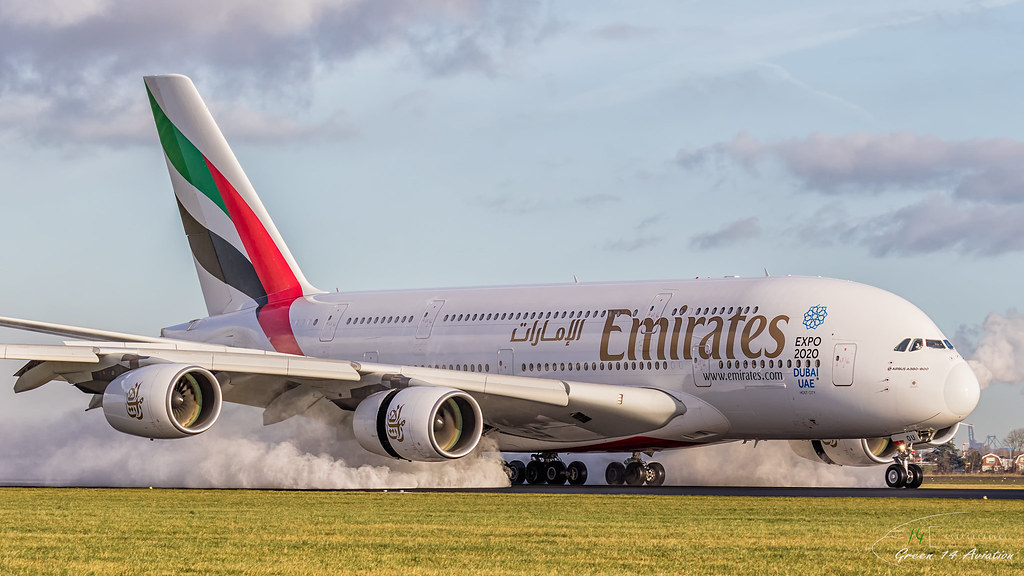The Airbus A380, the world’s largest passenger aircraft, is a marvel of engineering. You might assume that such a massive plane requires reverse thrust on all four engines to help it stop after landing. Surprisingly, the A380 is equipped with reverse thrust on only its two inner engines. In this article, we’ll explore the reasoning behind this design choice and how it contributes to the aircraft’s performance and efficiency.
Understanding Reverse Thrust

Reverse thrust is a technique used by jet engines to change the direction of airflow. Instead of expelling air out the back, the engines redirect the air towards the front when reverse thrust is activated. This helps slow down the aircraft, particularly on wet runways where the reverse thrust’s airflow kicks up water.
Read more about the Reverse thrust: Reverse Thrust in Airplanes and how it Functions
Although reverse thrust aids in decelerating an A380, brakes and spoilers play a more significant role in stopping the aircraft. Additionally, A380s land at relatively slow speeds, crossing the landing threshold at 140 knots and sometimes touching down as slow as 130 knots. Despite being larger and heavier than a Boeing 747-400, the Airbus A380 generally lands at a more leisurely pace.
Design Considerations for the A380’s Reverse Thrust

When designing the A380, there was a debate about whether reverse thrust should be included at all. The aircraft was designed to come to a complete stop using only its brakes. However, it was ultimately decided to equip two engines with reverse thrust to minimize the risk of aquaplaning. The designers concluded that having reverse thrust on all four engines would create more problems than it would solve.
Why the A380 Only Has Reverse Thrust on Two Engines?

The first reason the A380 has reverse thrust only on its inner engines is that it’s sufficient for its needs. Adding more reverse thrust would increase the plane’s weight and stress the wing structures. Equipping a single A380 engine with reverse thrust adds half a tonne of weight. Considering a fully-loaded A380 weighs up to 1,265,000 pounds and is already costly to operate, no one wants to burden the aircraft with unnecessary weight.
Another reason for not having reverse thrust on the A380’s outer engines is the potential hazard it poses on narrower runways. With an 80-meter wingspan, the outer engines may hang close to or over the edge of the runway. Increased energy output from these engines raises the risk of debris damaging the wings and fuselage. Turbulence during landing, especially around the runway’s perimeter, can be hazardous. However, this issue is less concerning during takeoff, as the aircraft leaves turbulence in its wake.
Airbus recommends that A380s operate on runways with a width of 60 meters. On such a runway, the outboard engines remain well within the boundary. Airbus also permits A380 operations on runways as narrow as 45 meters, provided there is a stabilized surface on the runway’s shoulders.
It may seem counterintuitive for such a large and heavy aircraft like the A380 to stop so efficiently without reverse thrust on all its engines. However, the A380 is a testament to remarkable engineering, capable of landing safely with only reverse thrust on its inner engines.
Have you ever been on an Airbus A380? Share your experience with this impressive aircraft in the comments below.
Featured image’s source: Ramon Kok
Youssef Yahya is the CEO and Founder of Aviation for Aviators, a platform dedicated to the aviation industry. With over 3 years of experience as an aviation writer, Youssef is passionate about sharing his insights on aviation, entrepreneurship, and the broader business landscape. As a Teaching Assistant in Entrepreneurship at Nile University, he also nurtures the next generation of entrepreneurs. When he’s not exploring the skies or business ventures, you can find him saying, ‘Drag your coffee, and let’s talk aviation, entrepreneurship, and football.’
You might also like:
- How Head-Up-Display (HUD) Works?
- Iberia Completes the First Airbus A321XLR Commercial Flight
- Why Airlines are Converting Passenger Jets to Freighters?
- Boeing Resumes 767 Deliveries After Three-Month Pause
- 28 Years Ago: The Hijacked Ethiopian Airlines Flight 961
Discover more from Aviation for Aviators
Subscribe to get the latest posts sent to your email.


I flew twice with a A380 of Singapore Airlines from Singapore to Paris and back when the company stopped flying the Boeing 777 and had more seats available. This in conjunction with a ticket for the TGV Thalys to Amsterdam and return on my holliday travels. Both a seat in Economic class, once downstairs and once upstairs with a great view. Flights were quiet en smooth. Living in Australia.